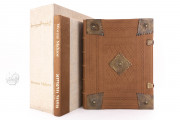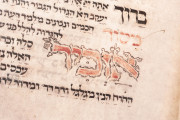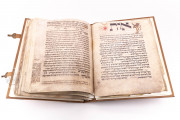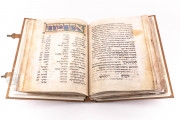The Worms Mahzor is a two-volume Jewish festival prayer book. Its first volume was produced in 1272, probably in Würzburg, by the scribe Simha ben Judah at the behest of his uncle Barukh ben Isaac. It contains the oldest dated Yiddish text, a rhymed blessing. The second volume was created later, probably in Worms, where the pair of books served the local Jewish community. The earlier volume features marginal painted medallions and word panels with animal and human figures. An illustration of the Book of Ruth was added in the fifteenth century.
The Mahzor of Worms is among the oldest known prayer books written for the Ashkenazic rite and an excellent testimony to Jewish book illumination in the Middle Ages.
A Richly Illuminated Mahzor
A Mahzor (Hebrew for "cycle") contains the prayers ever recurring at high festivals and thus constitutes a collection of festival prayers for liturgical use. The Worms Mahzor was used by the cantors of Worms for more than 650 years as their "official" festival prayer book.
While early manuscripts of this type were only sparsely illustrated, the Worms Mahzor develops a very special decoration pattern. Virtually all festivals are illustrated to accompany the relevant text. These illuminated scenes reflect the life of the Ashkenazic community of this period and their mentality.
The Decorative Apparatus
The illustrations in the Worms Mahzor draw from earlier sources or are original works by the master artist who painted this prayer book. The style indicates a clear influence from contemporary painting schools in the Rhineland.
Among the most fascinating aspects of the Worms Mahzor are the human figures, portrayed with bird-like beaks, shown in profile, and adorned with period-specific Jewish headgear. Additionally, some faces exhibit expressions despite lacking distinctive features. These characteristics were common in German Jewish manuscripts of the thirteenth and fourteenth centuries.
The Worms Mahzor also includes numerous depictions of animals, such as elephants, which are unique to this period of Jewish book illumination.
An Invaluable Source for Linguists
The illustrations in the Worms Mahzor are integrated within the text, written on large-format parchment in a square, calligraphic Ashkenazic hand, complete with vowels. According to the colophon, the scribe Simha ben Judah, whose father Yehuda of Nuremberg was also a professional scribe, produced this work on behalf of his uncle, Rabbi Barukh ben Isaac.
Vocalization was performed according to the pronunciation used for prayers and piyyutim (hymns of the Jewish liturgy) of the time. The text now serves as a crucial resource for research on the vocalization and pronunciation of the Hebrew language in medieval Germany.
Some verse couplets on folio 54r are particularly significant as they represent the oldest known example of text in the Yiddish language dated so far. These have aided researchers in understanding the beginnings of German Jewish literature. The content of the verse couplets is a blessing, not part of the original text, used as an ornament in a small hand and inserted in a reduced space within the Hebrew text.
We have 1 facsimile edition of the manuscript "Worms Mahzor": Das Worms Mahzor facsimile edition, published by Akademische Druck- u. Verlagsanstalt (ADEVA), 1985
Request Info / Price

























